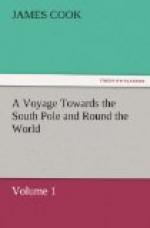The Dutch, in 1721, fitted out three ships to make discoveries in the South Pacific Ocean, under the command of Admiral Roggewein. He left the Texel on the 21st of August, and arriving in that ocean, by going round Cape Horn, discovered Easter Island, probably seen before, though not visited, by Davis;* then between 14 deg. 41’ and 15 deg. 47’ S. latitude, and between the longitude of 142 deg. and 150 deg. W., fell in with several other islands, which I take to be some of those seen by the late English navigators. He next discovered two islands in latitude 15 deg. S., longitude 170 deg. W., which he called Baumen’s Islands; and, lastly, Single Island, in latitude 13 deg. 41’ S., longitude 171 deg. 30’ W. These three islands are, undoubtedly, the same that Bougainville calls the Isles of Navigators.
[* See Waser’s description of the Isthmus of Darien.]
1738 Bouvet.
In 1738, the French East India Company sent Lozier Bouvet with two ships, the Eagle and Mary, to make discoveries in the South Atlantic Ocean. He sailed from Port L’Orient on the 19th of July in that year; touched at the island of St Catherine; and from thence shaped his course towards the south-east.
On the 1st of January, 1739, he discovered land, or what he judged to be land, in latitude 54 deg. S., longitude 11 deg. E. It will appear in the course of the following narrative, that we made several attempts to find this land without success. It is, therefore, very probable, that what Bouvet saw was nothing more than a large ice-island. From hence he stood to the east, in 51 deg. of latitude to 35 deg. of E. longitude: After which the two ships separated, one going to the island of Mauritius, and the other returning to France.
After this voyage of Bouvet, the spirit of discovery ceased, till his present majesty formed a design of making discoveries, and exploring the southern hemisphere; and, in the year 1764, directed it to be put in execution.
1764 Byron.
Accordingly Commodore Byron, having under his command the Dolphin and Tamer, sailed from the Downs on the 21st of June the same year; and having visited the Falkland Islands, passed through the Straits of Magalhaens into the Pacific Ocean, where he discovered the islands of Disappointment, George’s, Prince of Wales’s, the isles of Danger, York Island, and Byron Island.
1766 Wallis.
He returned to England the 9th of May, 1766, and, in the month of August following, the Dolphin was again sent out under the command of Captain Wallis, with the Swallow, commanded by Captain Carteret.
They proceeded together, till they came to the west end of the Straits of Magalhaens, and the Great South Sea in sight, where they were separated.
Captain Wallis directed his course more westerly than any navigator had done before him in so high a latitude; but met with no land till he got within the tropic, where he discovered the islands of Whitsunday, Queen Charlotte, Egmont, Duke of Gloucester, Duke of Cumberland, Maitea, Otaheite, Eimeo, Tapamanou, How, Scilly, Boscawen, Keppel, and Wallis; and returned to England in May, 1768.




